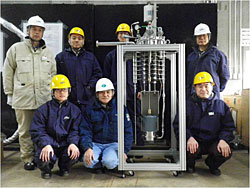Research & Development
JAXA promotes three research and development programs and a fundamental research program that underpins them.
Stabilizing cryogenic fuel systems
World's first successful transfer of liquid hydrogen with superconducting pump
JAXA are conducting research on technology for safely supplying liquid hydrogen with the aim of enabling future aircraft such as hypersonic transport to utilize liquid hydrogen fuel, which is used by the H-IIA launch vehicle. With demonstration tests in March 2012, through collaborative research with Associate Professor Kazuhiro Kajikawa of Kyushu University, we succeeded in the world's first transport of liquid hydrogen with a superconducting pump.
With demonstration tests conducted at the Noshiro Rocket Testing Center, a magnesium diboride (MgB2) superconducting motor, immersion-cooled in a container filled with liquid hydrogen, was operated synchronously at a maximum of 1,800 rpm to transfer liquid hydrogen to a different container at 6.5 liters/minute. Magnesium diboride wire rods manufactured by Hitachi, Ltd. were used as the superconductive material, and the High Temperature Superconducting Induction/Synchronous Machine (HTS-ISM) concept proposed by Associate Professor Taketsune Nakamura of Kyoto University was utilized for the motor. Using superconductive material, a more efficient and compact pump system than conventional ones could be realized. Through the success of this test, the outlook for realizing a safe liquid hydrogen supply system with little evaporative loss and no fear of bumping was provided.
Based on the knowledge that we have obtained, we intend to conduct a practical study of aircraft pump systems. The New Energy and Industrial Technology Development Organization (NEDO) has provided support in the development of a superconducting pump for liquid hydrogen.

July 31, 2012